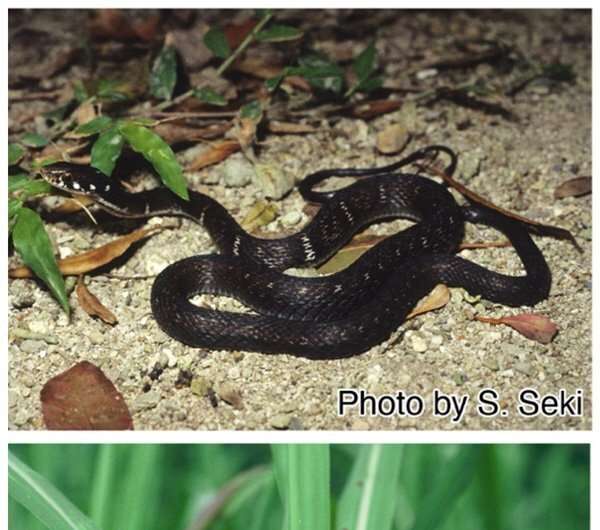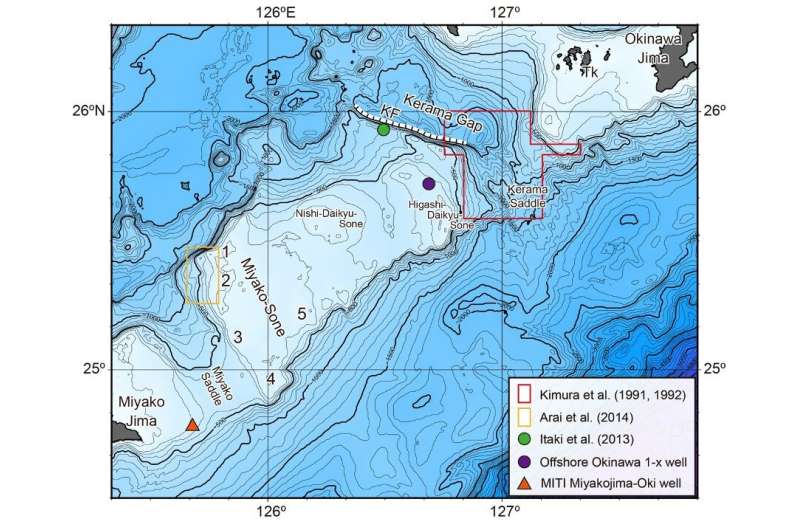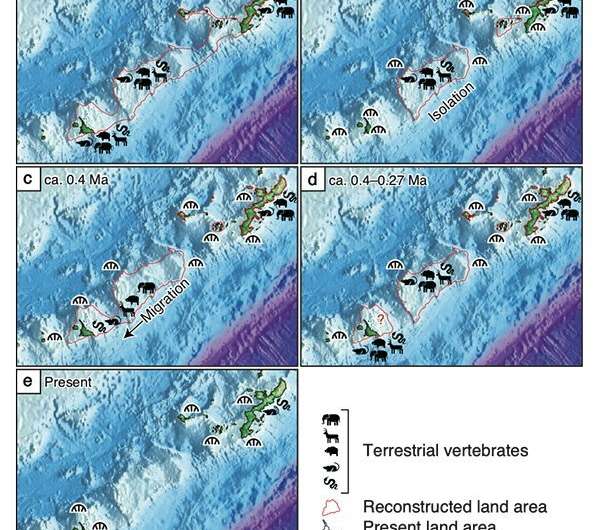This article has been reviewed according to Science X's editorial process and policies. Editors have highlighted the following attributes while ensuring the content's credibility:
fact-checked
trusted source
proofread
Missing island explains emergence of endemic species on the Miyako islands

Did an ancient island facilitate migration among the Ryukyu Islands? Compiling the latest geological and biological data, a research group from Tohoku University has provided compelling evidence that this was the case.
The Ryukyu Islands stretch from the southwestern coast of Kyushu all the way to the eastern part of Taiwan. This island chain is home to an array of endemic species such as the venomous snake Habu, or wild black rabbits know as Amami rabbits.
Even within the differing islands, unique species can be found. Sitting 300 kilometers to the southwest of Okinawa, the Miyako Islands are home to the Miyako keelback snake (Hebius concelarus) and the Miyako grass lizard (Takydromus toyamai).
Despite being separated by the Kerema Gap, these species are closely related to taxa/lineages/populations found on Okinawa and more northern islands and land areas, more so than the Yaeyama Islands, which are located to the southwest of the Miyako Islands and much closer in distance. Additionally, these species have limited ability to travel over water, leading to questions as to when and how they got there.

Largely flat, with the highest point standing at 110 meters, the Miyako Islands are entirely covered with a type of limestone known as the Ryukyu Group. Based on their distribution location and ages, scientists know that the Ryukyu Group were deposited between 1.25 and 0.4 million years ago, during which the sea levels fluctuated, repeatedly submerging the Miyako Islands.
Molecular phylogenetic analysis estimates that the Miyako keelback snake became an independent species around 3.7–1.8 million years ago. But this contradicts evidence that Miyako Island was submerged before 2 million years ago, and it was not until roughly 400,000 years ago that it became the land it is today, after which organisms began arriving.
Further muddying the waters is that deposits in limestone caves and fissures have contained Habu fossils, which are not native to the Miyako Islands. These fossils date back to 26,800–8,700 years ago.

A new explanation
Yasufumi Iryu, a professor at Tohoku University's Department of Earth Sciences within the Graduate School of Science who has studied the Ryukyu Group for over 40 years, has proposed a new hypothesis to account for such inconsistencies and in light of the latest geological and biological data. Details of the research were published in the journal Progress in Earth and Planetary Science on July 20, 2023.
"We believe that a land area between Okinawa and Miyako existed from 5.5 million years ago to 270,000 years ago. This island served as a transit site for biological migration from Okinawa to the Miyako Islands."
Iryu and his team dub the hypothesis the Okinawa-Miyako Submarine Plateau (OMSP) hypothesis. It incorporates plate tectonics into the mix of evidence, something previous explanations surrounding migratory patterns to the Ryukyu Islands have failed to do.
It proports that the vertical component (up to 1000 m displacement) of the right-lateral strike-slip faulting that formed the Kerama Gap and the corresponding Chinen Disturbance Event drove the uplift. Migration from the OMSP landmass to the Miyako Islands occurred after they were uplifted 400,000 years ago and before the OMSP landmass was submerged around 270,000 years ago.
Iryu states that their results rest on the integration of various data sources. "By combining relevant geological and phytogeographic data, we have been able to explain the enigmatic composition of modern and Late Pleistocene terrestrial fauna of the Miyako Islands. The study also highlights the high scientific value of the Miyako Island biota and will hopefully lead to greater protection and conservation of endemic species."
More information: Nana Watanabe et al, Geological history of the land area between Okinawa Jima and Miyako Jima of the Ryukyu Islands, Japan, and its phylogeographical significance for the terrestrial organisms of these and adjacent islands, Progress in Earth and Planetary Science (2023). DOI: 10.1186/s40645-023-00567-x
Provided by Tohoku University




















